CITROEN JUMPY 2008 Service Manual
Manufacturer: CITROEN, Model Year: 2008, Model line: JUMPY, Model: CITROEN JUMPY 2008Pages: 252, PDF Size: 12.15 MB
Page 41 of 252
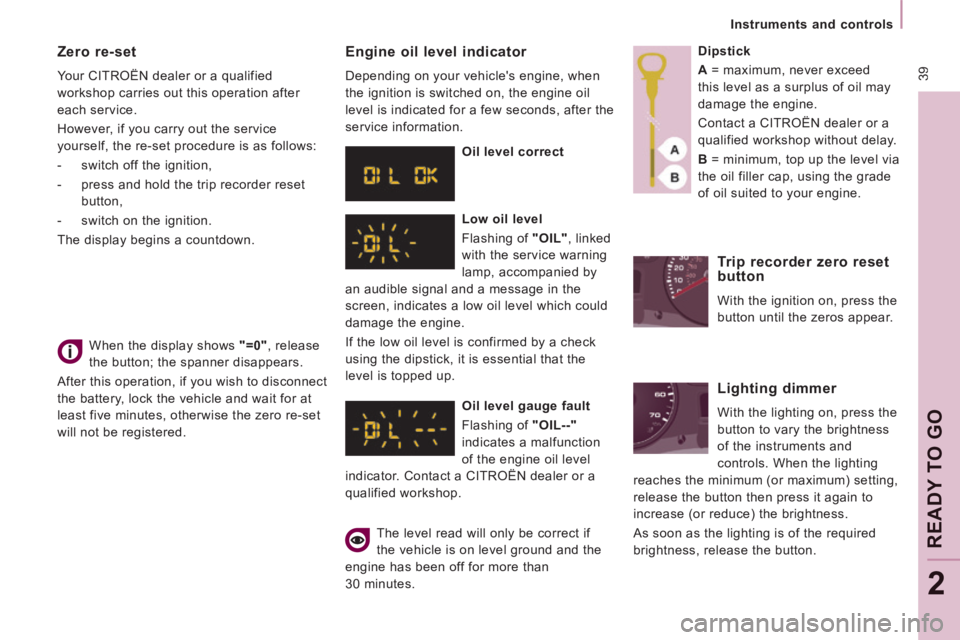
39
Instruments and controls
READY TO GO
2
When the display shows "=0" , release
the button; the spanner disappears.
After this operation, if you wish to disconnect
the battery, lock the vehicle and wait for at
least five minutes, otherwise the zero re-set
will not be registered.
Zero re-set
Your CITROËN dealer or a qualified
workshop carries out this operation after
each service.
However, if you carry out the service
yourself, the re-set procedure is as follows:
- switch off the ignition,
- press and hold the trip recorder reset button,
- switch on the ignition.
The display begins a countdown.
Engine oil level indicator
Depending on your vehicle's engine, when
the ignition is switched on, the engine oil
level is indicated for a few seconds, after the
service information.
Oil level correct
Low oil level
Flashing of "OIL" , linked
with the service warning
lamp, accompanied by
an audible signal and a message in the
screen, indicates a low oil level which could
damage the engine.
If the low oil level is confirmed by a check
using the dipstick, it is essential that the
level is topped up.
Oil level gauge fault
Flashing of "OIL--"
indicates a malfunction
of the engine oil level
indicator. Contact a CITROËN dealer or a
qualified workshop.
The level read will only be correct if
the vehicle is on level ground and the
engine has been off for more than
30 minutes. Dipstick
A
= maximum, never exceed
this level as a surplus of oil may
damage the engine.
Contact a CITROËN dealer or a
qualified workshop without delay.
B = minimum, top up the level via
the oil filler cap, using the grade
of oil suited to your engine.
Trip recorder zero reset
button
With the ignition on, press the
button until the zeros appear.
Lighting dimmer
With the lighting on, press the
button to vary the brightness
of the instruments and
controls. When the lighting
reaches the minimum (or maximum) setting,
release the button then press it again to
increase (or reduce) the brightness.
As soon as the lighting is of the required
brightness, release the button.
Page 42 of 252
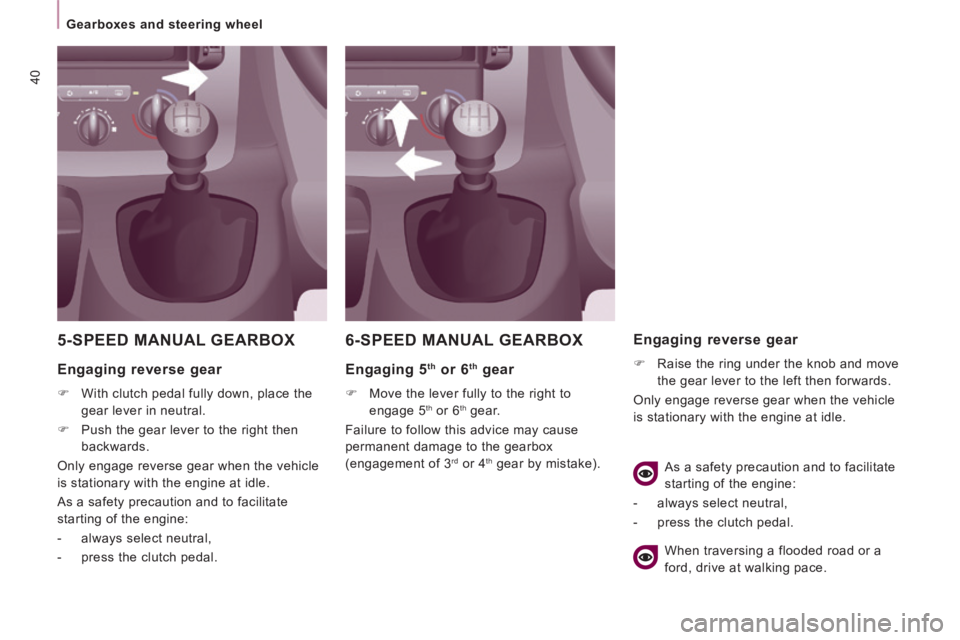
40
Gearboxes and steering wheel
5-SPEED MANUAL GEARBOX
Engaging reverse gear
With clutch pedal fully down, place the
gear lever in neutral.
Push the gear lever to the right then
backwards.
Only engage reverse gear when the vehicle
is stationary with the engine at idle.
As a safety precaution and to facilitate
starting of the engine:
- always select neutral,
- press the clutch pedal.
6-SPEED MANUAL GEARBOX
Engaging 5 th or 6 th gear
Move the lever fully to the right to
engage 5 th or 6 th gear.
Failure to follow this advice may cause
permanent damage to the gearbox
(engagement of 3
rd or 4 th gear by mistake).
Engaging reverse gear
Raise the ring under the knob and move
the gear lever to the left then forwards.
Only engage reverse gear when the vehicle
is stationary with the engine at idle.
When traversing a flooded road or a
ford, drive at walking pace. As a safety precaution and to facilitate
starting of the engine:
- always select neutral,
- press the clutch pedal.
Page 43 of 252
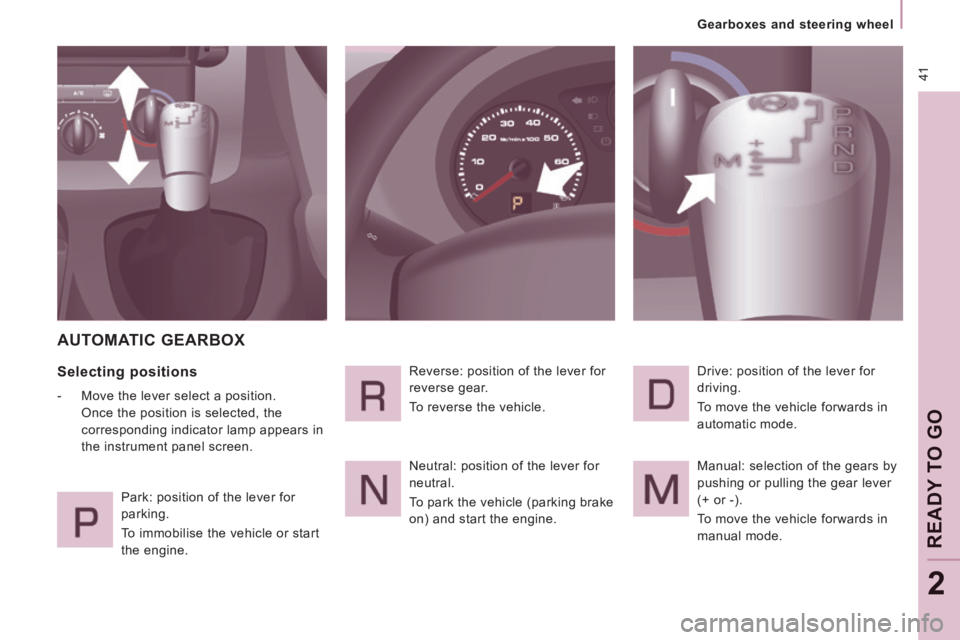
41
READY TO GO
2
Gearboxes and steering wheel
AUTOMATIC GEARBOX
Selecting positions
- Move the lever select a position. Once the position is selected, the
corresponding indicator lamp appears in
the instrument panel screen.
Park: position of the lever for
parking.
To immobilise the vehicle or start
the engine. Reverse: position of the lever for
reverse gear.
To reverse the vehicle.
Neutral: position of the lever for
neutral.
To park the vehicle (parking brake
on) and start the engine.
Drive: position of the lever for
driving.
To move the vehicle forwards in
automatic mode.
Manual: selection of the gears by
pushing or pulling the gear lever
(+ or -).
To move the vehicle forwards in
manual mode.
Page 44 of 252

42
Gearboxes and steering wheel
Moving off
With the engine running, to move off from
position P .
For immediate maximum acceleration
without touching the gear lever,
depress the accelerator pedal to the extent
of its travel, passing the point of resistance
(kickdown). The gearbox will automatically
change down or maintain the gear selected
until maximum engine speed is reached.
On a descent, the gearbox will automatically
change down in order to provide efficient
engine braking and good pickup.
If you take your foot off the accelerator
suddenly, the gearbox will not change to a
higher gear for reasons of safety.
When stationary with the gear lever in
position D (drive), a vibration limiting device
is activated by pressing the brake pedal.
- gradually release the
pressure on the brake pedal;
the vehicle then moves off.
- Press the brake pedal to
come out of position P ,
- select position R or D ,
- gradually release the pressure on the brake pedal;
the vehicle then moves off.
You can also move off from position N .
- With your foot on the brake, release
the parking brake,
- select position R , D or M ,
- Select position D . The gearbox always selects the most
suitable gear taking account of the following:
- the style of driving,
- the road profile,
- the vehicle load.
The gearbox is then operating in auto-
adaptive mode, without any action on your
part.
Reverse gear
- Select position R
, with the
vehicle stationary and the
engine at idle.
Stopping the vehicle, starting the
engine
- Select position P to
immobilise the vehicle or
to start the engine , with the
parking brake on or off.
If the battery is flat and the gear lever
is in position P , it will be impossible to
change to another position.
- You can also select position N
to park or to start the
engine , with the parking
brake on.
If position N is engaged inadvertently
while driving, allow the engine to return
to idle before engaging position D to restore
drive.
Page 45 of 252

43
READY TO GO
2
Gearboxes and steering wheel
Manual mode
Manual sequential gear changing.
- Select gear lever position M ,
- push the gear lever towards the + sign to change up, from 1 through to 6,
- conversely, push the gear lever towards the - sign to change down.
You can change from position D
(automatic mode) to position M
(manual mode) at any time.
In manual mode, it is only possible to
change from one gear to another if the
vehicle speed and engine speed permit.
If they do not, the vehicle will operate
temporarily in automatic mode.
When the vehicle is stationary or moving
very slowly, the gearbox automatically
selects first gear.
Good practice
Never select position N when the vehicle is
moving.
Never select positions P or R unless the
vehicle is stationary.
Never change between positions to optimise
braking on a slippery surface.
There is a risk of damage to the gearbox:
- if you press the accelerator and brake pedals at the same time,
- if you force the gear lever from position P to another position in the
event of a battery failure.
When the engine is at idle, brakes not
applied, if position R , D or M is selected the
vehicle moves even without the accelerator
being pressed.
For this reason, do not leave children
unsupervised inside the vehicle, with the
engine running .
Operating fault
Any operating fault is indicated by an
audible signal, accompanied by the
message "Automatic gear fault" in the
screen.
In this situation the gearbox operates in
downgrade mode (locked in 3rd gear). You
may feel a substantial knock when changing
from P to R and from N to R (this will not
cause any damage to the gearbox).
Do not exceed 60 mph (100 km/h), keeping
within the limit of local speed restrictions.
Contact a CITROËN dealer or a qualified
workshop as soon as possible.
When traversing a flooded road or a
ford, drive at walking pace.
Page 46 of 252
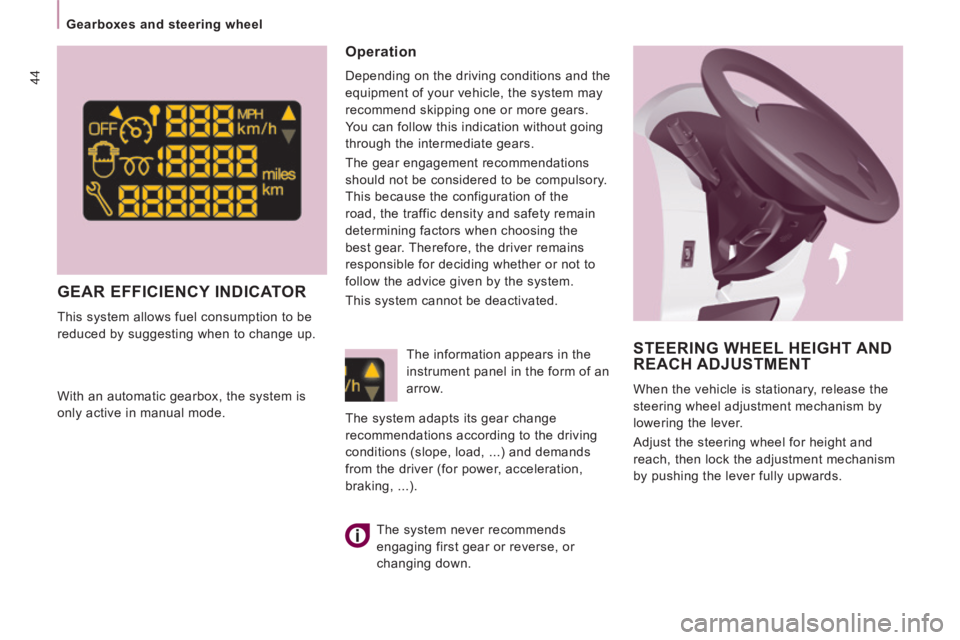
44
Gearboxes and steering wheel
GEAR EFFICIENCY INDICATOR
This system allows fuel consumption to be
reduced by suggesting when to change up. The information appears in the
instrument panel in the form of an
arrow.
The system adapts its gear change
recommendations according to the driving
conditions (slope, load, ...) and demands
from the driver (for power, acceleration,
braking, ...).
Operation
Depending on the driving conditions and the
equipment of your vehicle, the system may
recommend skipping one or more gears.
You can follow this indication without going
through the intermediate gears.
The gear engagement recommendations
should not be considered to be compulsory.
This because the configuration of the
road, the traffic density and safety remain
determining factors when choosing the
best gear. Therefore, the driver remains
responsible for deciding whether or not to
follow the advice given by the system.
This system cannot be deactivated.
The system never recommends
engaging first gear or reverse, or
changing down.
STEERING WHEEL HEIGHT AND REACH ADJUSTMENT
When the vehicle is stationary, release the
steering wheel adjustment mechanism by
lowering the lever.
Adjust the steering wheel for height and
reach, then lock the adjustment mechanism
by pushing the lever fully upwards.
With an automatic gearbox, the system is
only active in manual mode.
Page 47 of 252
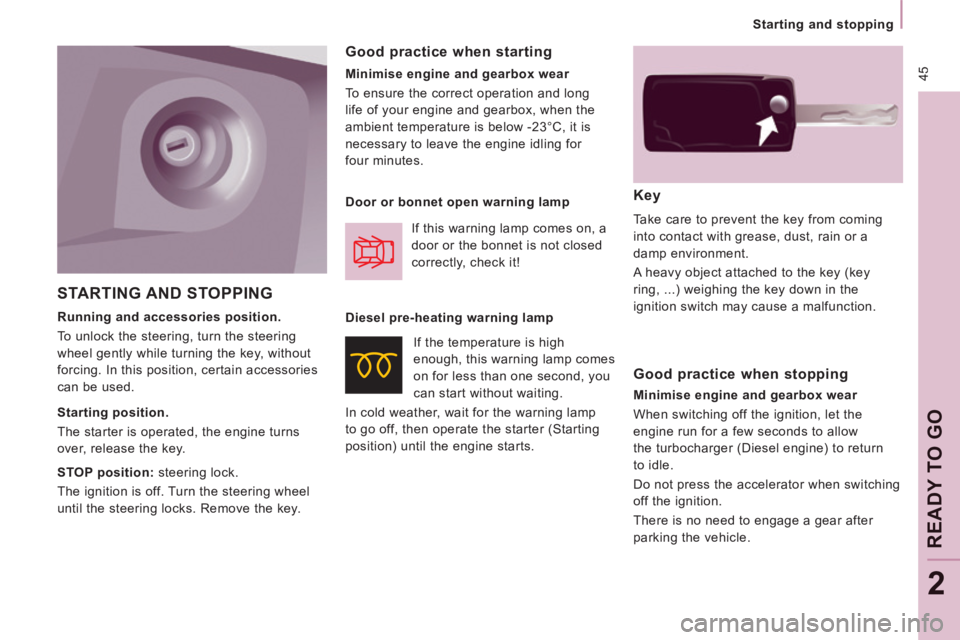
45
Starting and stopping
READY TO GO
2
STARTING AND STOPPING
Key
Take care to prevent the key from coming
into contact with grease, dust, rain or a
damp environment.
A heavy object attached to the key (key
ring, ...) weighing the key down in the
ignition switch may cause a malfunction.
Good practice when starting
Minimise engine and gearbox wear
To ensure the correct operation and long
life of your engine and gearbox, when the
ambient temperature is below -23°C, it is
necessary to leave the engine idling for
four minutes.
Door or bonnet open warning lamp If this warning lamp comes on, a
door or the bonnet is not closed
correctly, check it!
Good practice when stopping
Minimise engine and gearbox wear
When switching off the ignition, let the
engine run for a few seconds to allow
the turbocharger (Diesel engine) to return
to idle.
Do not press the accelerator when switching
off the ignition.
There is no need to engage a gear after
parking the vehicle.
Running and accessories position.
To unlock the steering, turn the steering
wheel gently while turning the key, without
forcing. In this position, certain accessories
can be used.
Starting position.
The starter is operated, the engine turns
over, release the key.
STOP position: steering lock.
The ignition is off. Turn the steering wheel
until the steering locks. Remove the key. If the temperature is high
enough, this warning lamp comes
on for less than one second, you
can start without waiting.
In cold weather, wait for the warning lamp
to go off, then operate the starter (Starting
position) until the engine starts. Diesel pre-heating warning lamp
Page 48 of 252
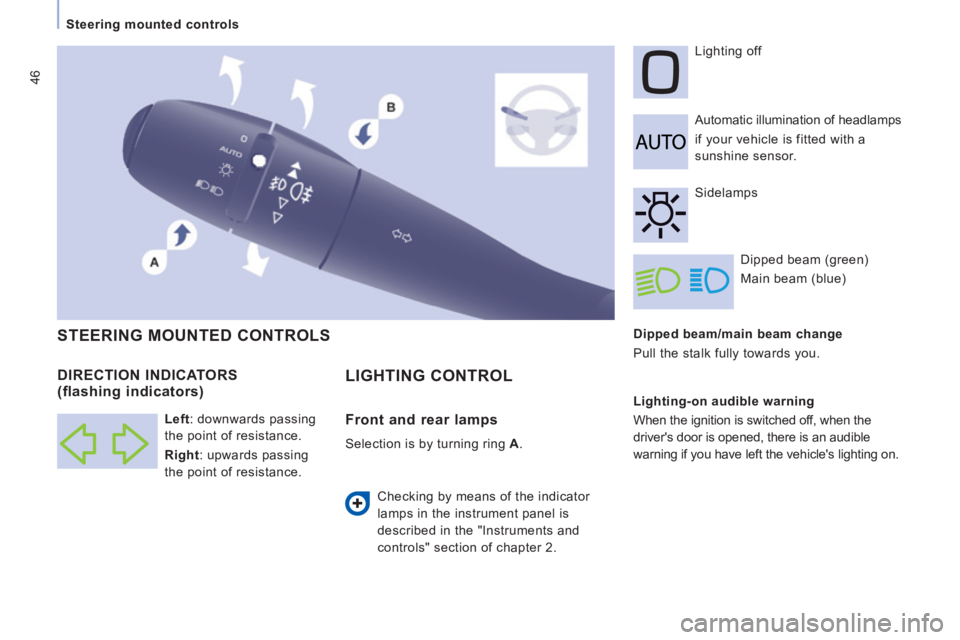
46
Steering mounted controls Dipped beam/main beam change
Pull the stalk fully towards you. Automatic illumination of headlamps
if your vehicle is fitted with a
sunshine sensor. Lighting off
Dipped beam (green)
Main beam (blue)
DIRECTION INDICATORS
(flashing indicators)
STEERING MOUNTED CONTROLS
Checking by means of the indicator
lamps in the instrument panel is
described in the "Instruments and
controls" section of chapter 2. Sidelamps
Lighting-on audible warning
When the ignition is switched off, when the
driver's door is opened, there is an audible
warning if you have left the vehicle's lighting on.
Left : downwards passing
the point of resistance.
Right : upwards passing
the point of resistance.
LIGHTING CONTROL
Front and rear lamps
Selection is by turning ring
A .
Page 49 of 252
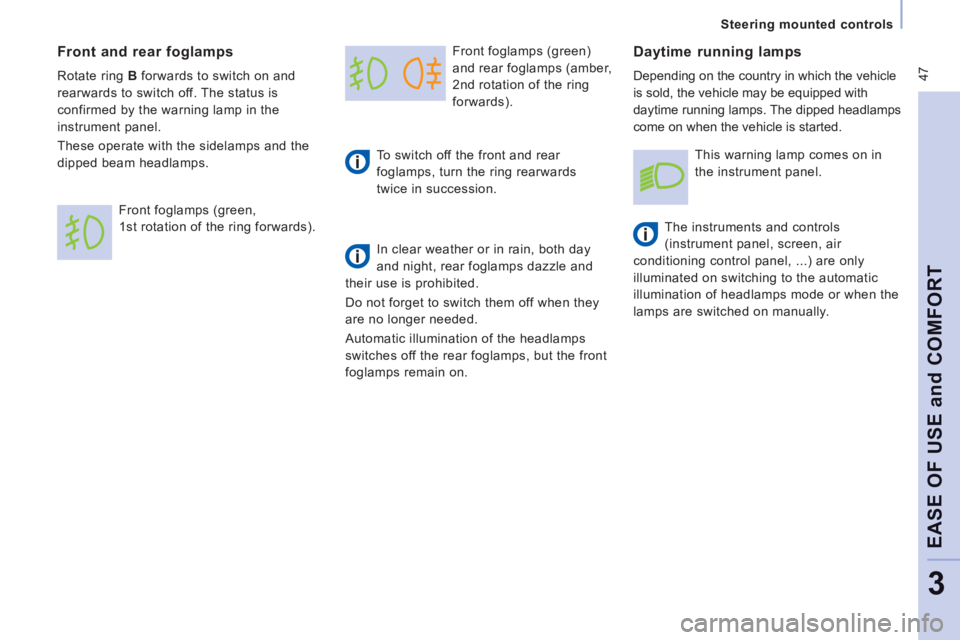
47
Steering mounted controls
EASE OF USE
and
COMFORT
3
Front foglamps (green)
and rear foglamps (amber,
2nd rotation of the ring
forwards).
To switch off the front and rear
foglamps, turn the ring rearwards
twice in succession.
In clear weather or in rain, both day
and night, rear foglamps dazzle and
their use is prohibited.
Do not forget to switch them off when they
are no longer needed.
Automatic illumination of the headlamps
switches off the rear foglamps, but the front
foglamps remain on. Daytime running lamps
Depending on the country in which the vehicle
is sold, the vehicle may be equipped with
daytime running lamps. The dipped headlamps
come on when the vehicle is started.
The instruments and controls
(instrument panel, screen, air
conditioning control panel, ...) are only
illuminated on switching to the automatic
illumination of headlamps mode or when the
lamps are switched on manually.
Front and rear foglamps
Rotate ring B forwards to switch on and
rearwards to switch off. The status is
confirmed by the warning lamp in the
instrument panel.
These operate with the sidelamps and the
dipped beam headlamps.
Front foglamps (green,
1st rotation of the ring forwards). This warning lamp comes on in
the instrument panel.
Page 50 of 252
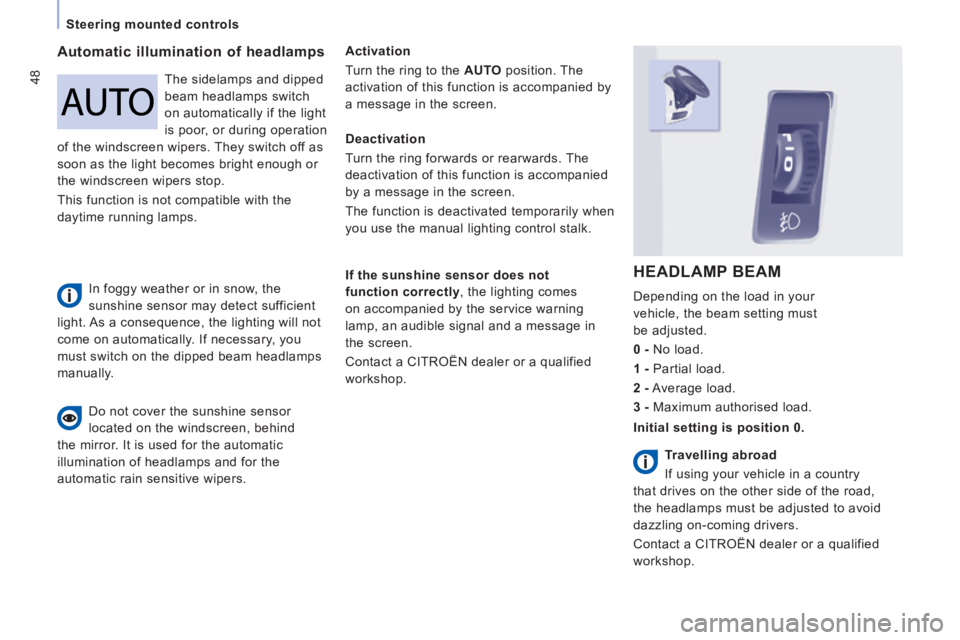
48
Steering mounted controls
Automatic illumination of headlamps Activation
Turn the ring to the AUTO position. The
activation of this function is accompanied by
a message in the screen.
If the sunshine sensor does not
function correctly , the lighting comes
on accompanied by the service warning
lamp, an audible signal and a message in
the screen.
Contact a CITROËN dealer or a qualified
workshop.
HEADLAMP BEAM
Depending on the load in your
vehicle, the beam setting must
be adjusted.
0 - No load.
1 - Partial load.
2 - Average load.
3 - Maximum authorised load.
Do not cover the sunshine sensor
located on the windscreen, behind
the mirror. It is used for the automatic
illumination of headlamps and for the
automatic rain sensitive wipers. The sidelamps and dipped
beam headlamps switch
on automatically if the light
is poor, or during operation
of the windscreen wipers. They switch off as
soon as the light becomes bright enough or
the windscreen wipers stop.
This function is not compatible with the
daytime running lamps. Deactivation
Turn the ring forwards or rearwards. The
deactivation of this function is accompanied
by a message in the screen.
The function is deactivated temporarily when
you use the manual lighting control stalk.
Initial setting is position 0.
In foggy weather or in snow, the
sunshine sensor may detect sufficient
light. As a consequence, the lighting will not
come on automatically. If necessary, you
must switch on the dipped beam headlamps
manually.
Travelling abroad
If using your vehicle in a country
that drives on the other side of the road,
the headlamps must be adjusted to avoid
dazzling on-coming drivers.
Contact a CITROËN dealer or a qualified
workshop.